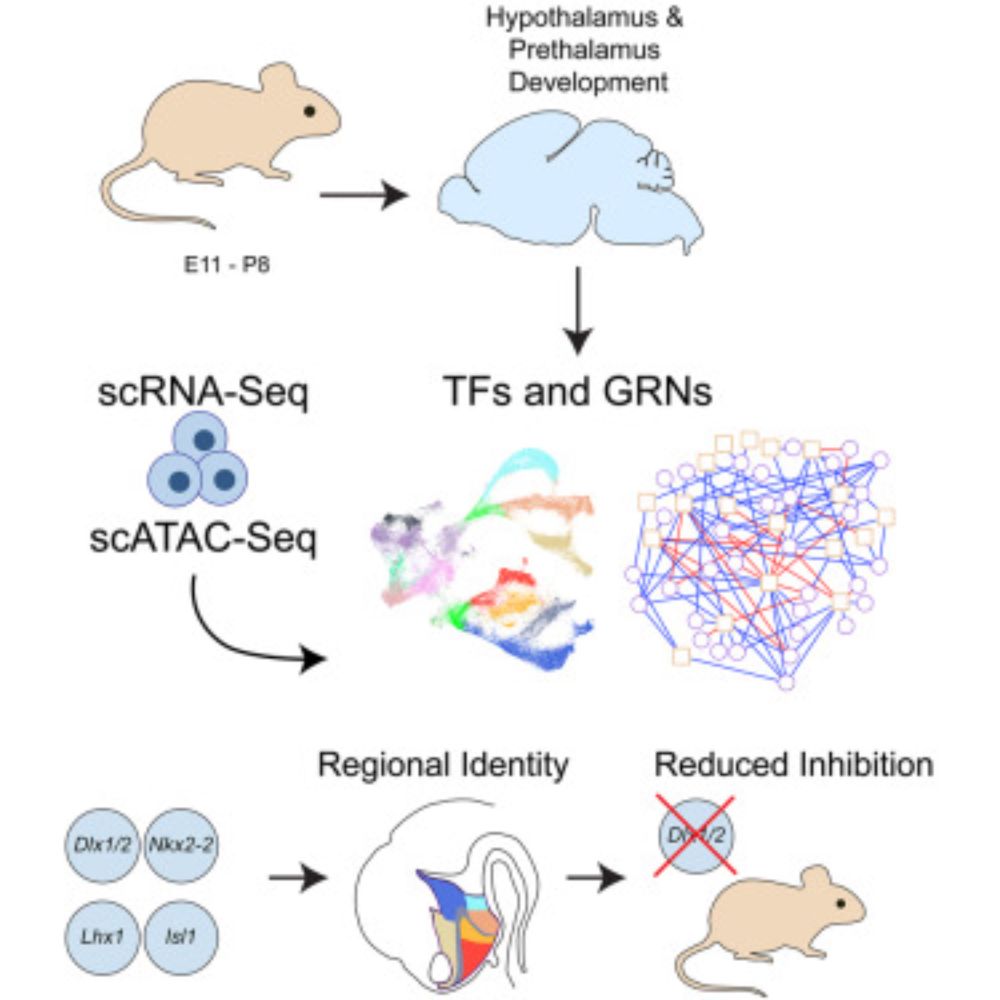
Seth Blackshaw
@sethblackshaw.bsky.social
Professor of Neuroscience. Studying neural development, regeneration, and control of innate behaviors at Johns Hopkins.
@sethblackshaw at Twitter.
@sethblackshaw at Twitter.
Very proud to have Leah working with us.
Leah Elias, Ph.D., is our Featured Fellow! Elias' postdoctoral research in @sethblackshaw.bsky.social's lab is dissecting how the need for restorative sleep is encoded into our brains at the level of cellular circuits and molecular signals. Her findings may reveal novel therapeutic targets ...
1/
1/

October 7, 2025 at 4:35 PM
Very proud to have Leah working with us.
Reposted by Seth Blackshaw
Leah Elias, Ph.D., is our Featured Fellow! Elias' postdoctoral research in @sethblackshaw.bsky.social's lab is dissecting how the need for restorative sleep is encoded into our brains at the level of cellular circuits and molecular signals. Her findings may reveal novel therapeutic targets ...
1/
1/

October 7, 2025 at 12:40 PM
Leah Elias, Ph.D., is our Featured Fellow! Elias' postdoctoral research in @sethblackshaw.bsky.social's lab is dissecting how the need for restorative sleep is encoded into our brains at the level of cellular circuits and molecular signals. Her findings may reveal novel therapeutic targets ...
1/
1/
Exciting new study shows that organoid-derived human retinal ganglion cells survive when apoptosis is genetically inhibited.
Excited to share my PhD work! We characterize waves of cell death during human retinal development, and show how blocking apoptosis promotes RGC long-term survival and alters their developmental dynamics in organoids. These findings will improve future organoid design for retinal disease modeling‼️
Check this paper from @simonomisz.bsky.social in our lab!
www.biorxiv.org/cgi/content/...
Human retinas/organoids go through 2 apoptotic waves. Organoids also have a necrotic wave. Blocking apoptosis promotes RGC survival to day 200 (usually die!). Apoptosis promotes normal neurogenesis/maturation.
www.biorxiv.org/cgi/content/...
Human retinas/organoids go through 2 apoptotic waves. Organoids also have a necrotic wave. Blocking apoptosis promotes RGC survival to day 200 (usually die!). Apoptosis promotes normal neurogenesis/maturation.
September 30, 2025 at 1:59 PM
Exciting new study shows that organoid-derived human retinal ganglion cells survive when apoptosis is genetically inhibited.
Our latest manuscript is out, and this one tackles the problem of cellular aging in the retina, using comparative multiomic analysis of zebrafish, mouse, and humans. What led us to work on aging after studying development and regeneration? Explainer follows./1
www.biorxiv.org/content/10.1...
www.biorxiv.org/content/10.1...

Comparative single-cell multiomic analysis reveals evolutionarily conserved and species-specific cellular mechanisms mediating natural retinal aging.
Biological age is a major risk factor in the development of common degenerative retinal diseases such as age-related macular degeneration and glaucoma. To systematically characterize molecular mechani...
www.biorxiv.org
September 12, 2025 at 7:04 PM
Our latest manuscript is out, and this one tackles the problem of cellular aging in the retina, using comparative multiomic analysis of zebrafish, mouse, and humans. What led us to work on aging after studying development and regeneration? Explainer follows./1
www.biorxiv.org/content/10.1...
www.biorxiv.org/content/10.1...
Reposted by Seth Blackshaw
👁️The retina — strikingly conserved across vertebrates, but an oddity among bilaterians!
So how did it evolve?
With @mikebok.bsky.social, @neurofishh.bsky.social and @denilsson.bsky.social, we argue that retinal complexity may 𝑝𝑟𝑒𝑑𝑎𝑡𝑒 𝑡ℎ𝑒 𝑒𝑦𝑒 𝑖𝑡𝑠𝑒𝑙𝑓.
www.biorxiv.org/content/10.1...
1/n
So how did it evolve?
With @mikebok.bsky.social, @neurofishh.bsky.social and @denilsson.bsky.social, we argue that retinal complexity may 𝑝𝑟𝑒𝑑𝑎𝑡𝑒 𝑡ℎ𝑒 𝑒𝑦𝑒 𝑖𝑡𝑠𝑒𝑙𝑓.
www.biorxiv.org/content/10.1...
1/n

a black and white dog is sitting on a couch with its tongue sticking out .
ALT: a black and white dog is sitting on a couch with its tongue sticking out .
media.tenor.com
September 12, 2025 at 12:58 PM
👁️The retina — strikingly conserved across vertebrates, but an oddity among bilaterians!
So how did it evolve?
With @mikebok.bsky.social, @neurofishh.bsky.social and @denilsson.bsky.social, we argue that retinal complexity may 𝑝𝑟𝑒𝑑𝑎𝑡𝑒 𝑡ℎ𝑒 𝑒𝑦𝑒 𝑖𝑡𝑠𝑒𝑙𝑓.
www.biorxiv.org/content/10.1...
1/n
So how did it evolve?
With @mikebok.bsky.social, @neurofishh.bsky.social and @denilsson.bsky.social, we argue that retinal complexity may 𝑝𝑟𝑒𝑑𝑎𝑡𝑒 𝑡ℎ𝑒 𝑒𝑦𝑒 𝑖𝑡𝑠𝑒𝑙𝑓.
www.biorxiv.org/content/10.1...
1/n
Reposted by Seth Blackshaw
Fantastic workshop !!!! Thank you again Seth and Michel !!!
September 6, 2025 at 8:12 AM
Fantastic workshop !!!! Thank you again Seth and Michel !!!
Our latest preprint is out, focusing on characterizing the response of Lhx6-positive neurons of the zona incerta (ZI) to naturally-occurring and experimentally-induced changes in the need to sleep, also known as sleep pressure.
www.biorxiv.org/content/10.1...
www.biorxiv.org/content/10.1...

Sleep pressure is differentially regulated by molecularly distinct subtypes of Lhx6-positive and Lhx6-negative neurons of the zona incerta
Sleep pressure, the accumulating drive towards sleep during wakefulness, is shaped by Lhx6-positive GABAergic neurons in the zona incerta (ZI). Here, we show that these neurons are broadly activated b...
www.biorxiv.org
August 5, 2025 at 2:04 PM
Our latest preprint is out, focusing on characterizing the response of Lhx6-positive neurons of the zona incerta (ZI) to naturally-occurring and experimentally-induced changes in the need to sleep, also known as sleep pressure.
www.biorxiv.org/content/10.1...
www.biorxiv.org/content/10.1...
Now up, positively our lab's last word on Ptbp1. Developmental loss of function Ptbp1 turns out not to regulate neurogenesis or cell fate specification at all, but does alter splicing patterns and slightly accelerates expression of photoreceptor-specific genes./1
www.biorxiv.org/content/10.1...
www.biorxiv.org/content/10.1...

Ptbp1 is not required for retinal neurogenesis and cell fate specification.
The RNA-binding protein Ptbp1 has been proposed as a master regulator of neuronal fate, repressing neurogenesis through its effects on alternative splicing and miRNA maturation. While prior studies us...
www.biorxiv.org
July 4, 2025 at 3:03 PM
Now up, positively our lab's last word on Ptbp1. Developmental loss of function Ptbp1 turns out not to regulate neurogenesis or cell fate specification at all, but does alter splicing patterns and slightly accelerates expression of photoreceptor-specific genes./1
www.biorxiv.org/content/10.1...
www.biorxiv.org/content/10.1...
Reposted by Seth Blackshaw
Job alert ‼️ @thomasdwkim.bsky.social and I are recruiting a postdoc in single-cell genomics via the NORPOD program of the @nordicembl.bsky.social. Collaboration between @fimm-uh.bsky.social and @dandrite.bsky.social on multimodal data integration in neurodevelopment.
jobs.helsinki.fi/job/Helsinki...
jobs.helsinki.fi/job/Helsinki...

Postdoctoral Researcher in Single-Cell Genomics through the NORPOD program
Postdoctoral Researcher in Single-Cell Genomics through the NORPOD program
jobs.helsinki.fi
June 25, 2025 at 8:36 AM
Job alert ‼️ @thomasdwkim.bsky.social and I are recruiting a postdoc in single-cell genomics via the NORPOD program of the @nordicembl.bsky.social. Collaboration between @fimm-uh.bsky.social and @dandrite.bsky.social on multimodal data integration in neurodevelopment.
jobs.helsinki.fi/job/Helsinki...
jobs.helsinki.fi/job/Helsinki...
New collaborative study out with Mark Wu’s group identifies a thalamic reuniens-zona incerta circuit as both responsive to induced sleep deprivation and essential for mediating recovery sleep. Further perspective on this work follows./1
www.science.org/doi/epdf/10....
www.science.org/doi/epdf/10....

Sleep need–dependent plasticity of a thalamic circuit promotes homeostatic recovery sleep
Prolonged wakefulness leads to persistent, deep recovery sleep (RS). However, the neuronal circuits that mediate this process remain elusive. From a circuit screen in mice, we identified a group of th...
www.science.org
June 19, 2025 at 6:45 PM
New collaborative study out with Mark Wu’s group identifies a thalamic reuniens-zona incerta circuit as both responsive to induced sleep deprivation and essential for mediating recovery sleep. Further perspective on this work follows./1
www.science.org/doi/epdf/10....
www.science.org/doi/epdf/10....
Our paper on gene regulatory networks controlling hypothalamic and prethalamic development is now out in Cell Reports./1
www.cell.com/cell-reports...
www.cell.com/cell-reports...

Decoding gene networks controlling hypothalamic and prethalamic neuron development
Kim et al. map gene regulatory networks of the developing mouse hypothalamus and prethalamus
using single-cell multiomics, identifying regulators of regionalization and neurogenesis.
They further show...
www.cell.com
June 14, 2025 at 12:48 AM
Our paper on gene regulatory networks controlling hypothalamic and prethalamic development is now out in Cell Reports./1
www.cell.com/cell-reports...
www.cell.com/cell-reports...
Meis1/2 are transcription factors that are predicted to regulate early-stage temporal identity in retina based on single-cell multiomic analysis. We tested whether Meis1/2 were sufficient to confer early temporal identity./1
www.biorxiv.org/content/10.1...
www.biorxiv.org/content/10.1...

Overexpression of Meis factors in late-stage retinal progenitors yields complex effects on temporal patterning and neurogenesis.
The vertebrate retina serves as a model for studying neurogenesis and cell fate specification, with retinal progenitor cells following a tightly regulated temporal sequence to generate distinct cell t...
www.biorxiv.org
May 2, 2025 at 12:03 PM
Meis1/2 are transcription factors that are predicted to regulate early-stage temporal identity in retina based on single-cell multiomic analysis. We tested whether Meis1/2 were sufficient to confer early temporal identity./1
www.biorxiv.org/content/10.1...
www.biorxiv.org/content/10.1...
OK everyone, you know what to do, particularly if you live in a red state with a major medical school.
donmoynihan.substack.com/p/the-nih-bu...
donmoynihan.substack.com/p/the-nih-bu...

The NIH budget is on a fast track to disaster
An NIH insider explains what Republicans are likely to do next, and what we can do
donmoynihan.substack.com
May 2, 2025 at 1:09 AM
OK everyone, you know what to do, particularly if you live in a red state with a major medical school.
donmoynihan.substack.com/p/the-nih-bu...
donmoynihan.substack.com/p/the-nih-bu...
New preprint from former lab member Joe Bedont on Bmal1 in hypothalamus tanycytes. Tanycyte-specific loss of function of Bmal1 inhibits both weight gain on high-fat diet and tanycyte-derived neurogenesis.
www.biorxiv.org/content/10.1...
www.biorxiv.org/content/10.1...

Tanycyte Bmal1 sex-specifically regulates weight gain and hypothalamic neurogenesis in female mice
The hypothalamic radial-glia-like tanycyte population plays important and intertwined roles in feeding and metabolism, reproduction, and seasonality. Although these processes are circadian-regulated a...
www.biorxiv.org
April 29, 2025 at 1:35 PM
New preprint from former lab member Joe Bedont on Bmal1 in hypothalamus tanycytes. Tanycyte-specific loss of function of Bmal1 inhibits both weight gain on high-fat diet and tanycyte-derived neurogenesis.
www.biorxiv.org/content/10.1...
www.biorxiv.org/content/10.1...
Our latest manuscript (7 years in the works) tackles the question of how diurnal ground squirrels evolved a cone-dominant retina, in contrast to the ancestral rod-dominant retina retained by virtually all other mammals./1
www.biorxiv.org/content/10.1...
www.biorxiv.org/content/10.1...

Heterochronic transcription factor expression drives cone-dominant retina development in 13-lined ground squirrels.
Evolutionary adaptation to diurnal vision in ground squirrels has led to the development of a cone-dominant retina, in stark contrast to the rod-dominant retinas of most mammals. The molecular mechani...
www.biorxiv.org
April 29, 2025 at 11:06 AM
Our latest manuscript (7 years in the works) tackles the question of how diurnal ground squirrels evolved a cone-dominant retina, in contrast to the ancestral rod-dominant retina retained by virtually all other mammals./1
www.biorxiv.org/content/10.1...
www.biorxiv.org/content/10.1...
The final version of our eLife manuscript on viral Oct4-mediated neurogenic reprogramming of retinal Muller glia is now out, with all reviewer comments addressed.
elifesciences.org/reviewed-pre...
elifesciences.org/reviewed-pre...
Viral-mediated Oct4 overexpression and inhibition of Notch signaling synergistically induce neurogenic competence in mammalian Müller glia
elifesciences.org
April 28, 2025 at 10:07 PM
The final version of our eLife manuscript on viral Oct4-mediated neurogenic reprogramming of retinal Muller glia is now out, with all reviewer comments addressed.
elifesciences.org/reviewed-pre...
elifesciences.org/reviewed-pre...
A second new study describes JACUZI-SD, a new method for efficiently and non-stressfully inducing sleep deprivation in larval zebrafish, which works by delivering randomized water pulses via a custom milli-fluidic device integrated with a 96-well plate.
www.biorxiv.org/content/10.1...
www.biorxiv.org/content/10.1...

JACUZI-SD: An automated, high-throughput, minimally stressful approach to sleep depriving larval zebrafish.
While sleep deprivation broadly disrupts health and well-being, the neural and molecular mechanisms that signal increased sleep pressure remain poorly understood. A key obstacle to progress is the fac...
www.biorxiv.org
April 5, 2025 at 3:14 PM
A second new study describes JACUZI-SD, a new method for efficiently and non-stressfully inducing sleep deprivation in larval zebrafish, which works by delivering randomized water pulses via a custom milli-fluidic device integrated with a 96-well plate.
www.biorxiv.org/content/10.1...
www.biorxiv.org/content/10.1...
Our latest manuscript on glia-to-neuron conversion in retina is out in @elife.bsky.social. We show that AAV-mediated overexpression of Oct4 induces glia-to-bipolar cell conversion in wildtype retina, and that this is greatly enhanced by loss of function of Rbpj.
elifesciences.org/reviewed-pre...
elifesciences.org/reviewed-pre...
Viral-mediated Oct4 overexpression and inhibition of Notch signaling synergistically induce neurogenic competence in mammalian Müller glia
elifesciences.org
April 5, 2025 at 2:59 PM
Our latest manuscript on glia-to-neuron conversion in retina is out in @elife.bsky.social. We show that AAV-mediated overexpression of Oct4 induces glia-to-bipolar cell conversion in wildtype retina, and that this is greatly enhanced by loss of function of Rbpj.
elifesciences.org/reviewed-pre...
elifesciences.org/reviewed-pre...
Reposted by Seth Blackshaw
Check out this tour de force work from @christ3na.bsky.social in my lab!
Her studies reveal how developmental timing in the retina is controlled like an hourglass. The progenitor:neuron ratio shifts to control signaling levels and trigger photoreceptor development over time. Check it out!!
Her studies reveal how developmental timing in the retina is controlled like an hourglass. The progenitor:neuron ratio shifts to control signaling levels and trigger photoreceptor development over time. Check it out!!
DIO3 coordinates photoreceptor development timing and fate stability in human retinal organoids https://www.biorxiv.org/content/10.1101/2025.03.20.644422v1
March 24, 2025 at 10:29 PM
Check out this tour de force work from @christ3na.bsky.social in my lab!
Her studies reveal how developmental timing in the retina is controlled like an hourglass. The progenitor:neuron ratio shifts to control signaling levels and trigger photoreceptor development over time. Check it out!!
Her studies reveal how developmental timing in the retina is controlled like an hourglass. The progenitor:neuron ratio shifts to control signaling levels and trigger photoreceptor development over time. Check it out!!
Standing up for science with lab members in DC yesterday.

March 8, 2025 at 5:08 PM
Standing up for science with lab members in DC yesterday.
Reposted by Seth Blackshaw
Nice story on fabulous new work from @dingliu.bsky.social in my lab, just out today!...
Two dueling sets of hypothalamic neurons—one that responds to isolation and one to reunion—help maintain a mouse's social homeostasis, a new study reveals.
By @avaskham.bsky.social
#neuroskyence
www.thetransmitter.org/social-behav...
By @avaskham.bsky.social
#neuroskyence
www.thetransmitter.org/social-behav...

Soft touch quells loneliness in mice
Touch modulates one of two dueling types of hypothalamic neurons that, thermostat-like, balance an animal’s drive for social interaction.
www.thetransmitter.org
February 26, 2025 at 5:08 PM
Nice story on fabulous new work from @dingliu.bsky.social in my lab, just out today!...
Our new review article with @michelcayouette.bsky.social is out on temporal patterning and glial reprogramming in adult CNS, and its implications for treating degenerative diseases. All work from our lab discussed here was funded by NIH.
authors.elsevier.com/a/1kfup3Q9h2...
authors.elsevier.com/a/1kfup3Q9h2...
authors.elsevier.com
February 25, 2025 at 1:30 PM
Our new review article with @michelcayouette.bsky.social is out on temporal patterning and glial reprogramming in adult CNS, and its implications for treating degenerative diseases. All work from our lab discussed here was funded by NIH.
authors.elsevier.com/a/1kfup3Q9h2...
authors.elsevier.com/a/1kfup3Q9h2...
Happy to make our own small contribution to this exciting new study from the Iijima and Sesaki labs on Parkin/PINK1-dependent regulation of mitochondrial fusion.
www.nature.com/articles/s41...
www.nature.com/articles/s41...

Dual regulation of mitochondrial fusion by Parkin–PINK1 and OMA1 - Nature
We find that, in mice, although the individual loss of Parkin or OMA1 does not affect mitochondrial integrity, their combined loss results in small body size, low locomotor activity, premature death, ...
www.nature.com
February 20, 2025 at 2:03 AM
Happy to make our own small contribution to this exciting new study from the Iijima and Sesaki labs on Parkin/PINK1-dependent regulation of mitochondrial fusion.
www.nature.com/articles/s41...
www.nature.com/articles/s41...
Reposted by Seth Blackshaw
Get ready to #standupforscience in 2.5 weeks!

February 16, 2025 at 7:16 PM
Get ready to #standupforscience in 2.5 weeks!

